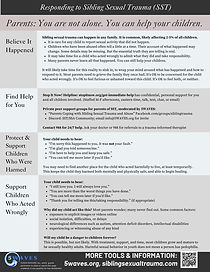Sexual Abuse Advocates
-
Educate staff that sibling sexual trauma is one of the most common types of sexual abuse.
-
Educate staff that sibling sexual trauma raises the risk of sexual victimization or exploitation later in life–which means that many survivors of other types of sexual assault may also have a history of sibling sexual trauma.
-
Share these printable 5WAVES flyers, to raise general awareness about sibling sexual trauma, and to help guide parents if it is disclosed. (available for US, UK & AU)



Examine your organization’s messaging, including words, images,
and stories. Does it include the possibility that:
-
A child or teen could have caused the harm?
-
A sibling or family member could have caused the abuse?
-
The survivor could be a male and/or the offender could be a female?
-
The child who caused harm could be younger than the survivor?
-
The person needing help may not clearly identify as a victim or perpetrator, or identify what happened as abuse or assault?
-
The survivor may have concern or ambivalent feelings about the welfare of the person who harmed them?
_edited_edited.png)

